This video is from a professional company and features the host of What's My Line, John Daly. He did a documentary, Peabody award winning, on Dr Dooley.
This video is from a professional company and features the host of What's My Line, John Daly. He did a documentary, Peabody award winning, on Dr Dooley.
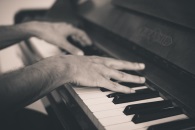
This is a professional video shot by John Daly as host, about Tom's efforts in Laos with interviews of Tom at the end.
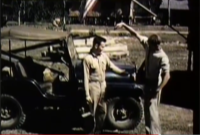
John Daly, the host Of What's My Line, the second longest running show of its kind, did a film called The Splendid American Featuring Fr Theodore Hesburgh among others.
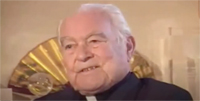
On Nov 22 1959 Dr Tom Dooley was give the CC Criss award, an award given in the name of Dr CC Criss, the first CEO of Mutual of Omaha (1933-1953).
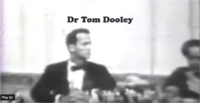
Fr Theodore Hesburgh was an admirer of Dr Tom Dooley and gave him an honorary doctorate with President Dwight Eisenhower, June 5, 1960. Fr Ted comments on that day.

On Nov 22 1959 Dr Tom Dooley was give the CC Criss award, an award given in the name of Dr CC Criss, the first CEO of Mutual of Omaha (1933-1953).

BEFORE YOU BEGIN THIS JOURNEY, take a look at Dr Dooley at the height of his popularity when he was on What's My Line November 22, 1959. Meet the man himself, Dr Tom Dooley, from the early days of television.
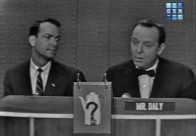
Prologue: Dr Tom Dooley led an incredible life from a very young age, but after his experiences in French-Indo China as a young doctor, literally his first assignment, he wrote a book Deliver Us From Evil, about the experience. His ideas were visionary.

Chapter One: Dr Tom Dooley talks to a high school crowd in Wilmette, IL, and tells the story of Maggie, the witch doctor, and how he worked with her.

Chapter Two: It is a good idea to understand Thomas A Dooley, Sr's wealth in simple terms. Envision the railroad making car company Thomas A Dooley built over 50 years at a time when railroad cars sold like hotcakes. The St Louis papers called it one of the largest industrial concerns in St Louis. This made Thomas A Dooley III's youth one of privilege which included piano lessons, and a familiarity with the thinking of the business elite. He also was an expert horseman with his own horses, while living in the center of the city.

Chapter Three: Dr Tom Dooley was actually Thomas A Dooley III. The story begins with Thomas A Dooley Sr., Dr Tom's grandfather. His story is best told above in Chapter Two and in this chapter you see the utter opulence of his Golden Jubilee dinner. If they can throw a party like this, there's pretty much nothing that they can't buy. This wealth benefited Dr Tom Dooley in his youth as not many people can imagine. Dr Tom was a world traveller before he was 21.

Chapter Four: Tom's early life and education.
"Before moving to exclusive Ladue in 1940 (St. Louis historian Ernest Kirschten called it the "swankiest of the dormitory satellites" the Dooleys lived in the Parkview section of the West End, near Washington University. Parkview was among the most attractive of St Louis's famed "private places" (the section of Parkview in which the Dooleys resided was located in University City, a community adjoining the western border of the city). The neighborhood was an enclave of affluent professionals including a fair share of Irish Americans, with physicians and attorneys predominating over industrialists like Thomas A. Dooley Jr. In St. Louis--as in most northern and midwestern cities--Catholics were known by the parish to which they belonged. Tommy Dooley attended St. Roch's parochial school until 1936, when he was enrolled in the fourth grade at the more prestigious Barat Hall, a private school operated by the Religious of the Sacred Heart at City House, a convent located behind the "new Cathedral," as St. Louisians still refer to the Romanesque edifice on Lindell Boulevard that was actually completed before World War I." Dr America.
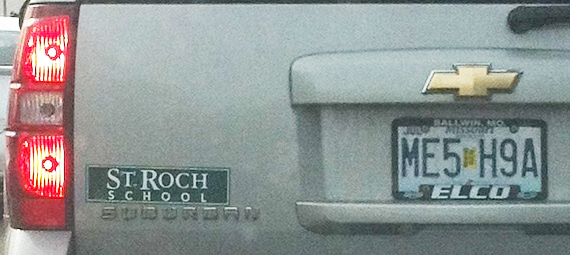
Chapter 5: Tom plays the piano at Larry Aggens home in approximately October 1959. A reporter named Lucy brought Tom to Wilmette and Larry showed the films of Operation Freedom lift and recorded the audio on tape. Larry and Tom are showing the film and the audio picks up their explanation. He says at the beginning of this clip that he heard this song on the radio, bought the sheet music and therefore was playing it for the first time. Lucille Sensor, secretary to Mrs Agnes Dooley, Tom's mom, says that Tom read music before he read the newspaper. So go ahead, enjoy this piece, listen to Tom, he was being taped in Wilmette, IL by his shipmate Larry Aggens. Some people thought Tom exaggerated his talents, you tell me, can Tom play the piano?

This video has been moved to the beginning of this book, and is only repeated here. Chapter 6: Later that same year he was on What's My Line, November 22, 1959. What's My Line is the second longest running show of it type in TV history. At this point he is now known as "The Splendid American," "Dr America," and "Bac My Sy," as well as Dr Tom Dooley. Listen to what Arlene Francis says when she figures out who the mystery guest is.

Chapter 7: Tom was called by the New York Times one of the first examples of a "celebrity saint." Tom shot these videos without sound, which was all you could do in those days, and here the narrator tells you what you are seeing in his films, this one from Vietnam, 1954. This is the American quarters during Operation Freedom Lift, where they were living like the French colonialists, and then Tom shows the An Lac Orphanage, and Madame Vu Ngai, the founder of An Lac Orphanage. The orphanage shown here is in North Vietnam, but the children were later moved to South Vietnam. At the Fall of Saigon, approximately 100 children were flown to the US with Madame Ngai, and Betty Tisdale of Seattle Washington was the American who coordinated it all in the US. All the children here were adopted by American families. In 2011, they had all grown to have their own families, and they had a reunion at Ft Bragg.
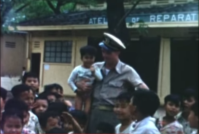
Chapter 8: Take another listen to Tom's piano playing. Tom plays the piano at Larry Aggens home in approximately October 1959. The Song here is Somewhere Over the Rainbow.

Chapter 9: Tom shows his first hospital and setup in Laos, at Vang Vieng. He creates signs that function like titles. Notice he lists Norman Baker, Dennis Shepard, and Peter Kessey. These were his three corpsman in North Vietnam and again in Laos. All served for two years before returning stateside.

Chapter 10: For now we will end with Tom playing again as taped by his shipmate, Larry Aggens, at Larry's home in Wilmette, IL. It's an hour north of Chicago by car. Tom plays the piano at Larry Aggens home in approximately October 1959. The Song here is Que sera sera. But for you fans who have made it this far, please go on to Book Two.












